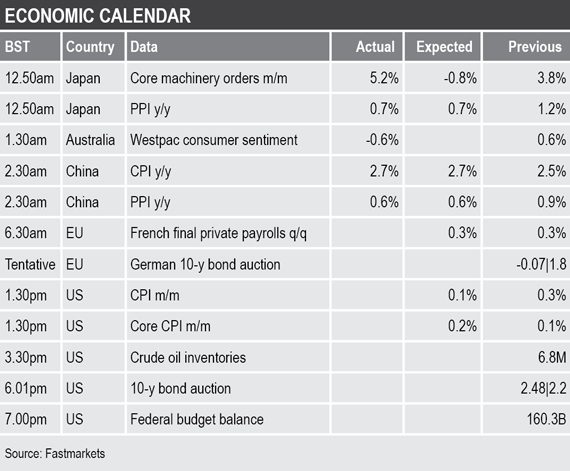Trump threatened more tariffs on Chinese imports if there is not enough progress on trade negotiations with China or if the meeting with President Xi does not happen during the summit. As such, the risk of a prolonged and escalated trade dispute remains a very real threat and this was enough to deter global investors from becoming too bullish.
As a result, appetite for risk assets has ebbed and the short-covering rallies in the London Metal Exchange base metals prices on Tuesday June 11 seem to have run their course.
Indeed, the LME’s three-month base metals prices were generally on a backfoot this morning and remain highly vulnerable to further selling if negative trade rhetoric continues.
- Although Trump has said he expects a meeting with Xi to take place, government officials from both sides have admitted that little preparatory work for the meeting has taken place while US-China tensions remain high.
- Global investors have already discounted the positive vibe from the US-Mexico trade deal. With no sign of further US-China trade negotiations seemingly likely, risk-averse investors have turned to haven assets again.
- The spot gold price is up by 0.7% and was trading at $1,336 per oz recently while the global bond yields that we follow were generally under downward pressure, an indication that global economic jitters are set to persist.
Base metals
The LME three-month base metals prices were trending lower on Wednesday morning, down by an average of 0.3% as at 6.33am London time. Following two solid green daily candles, lead was under renewed selling pressure this morning, with a decline of 0.9%. The rest were broadly weaker: zinc (-0.4%), aluminium (-0.3%) and copper (-0.2%), while nickel was unchanged and tin was the lone metal in positive territory with its three-month price up by 0.1%.
Meanwhile in China, base metals prices on the Shanghai Futures Exchange were more resilient after the complex managed to eke out marginal gains on Wednesday, with prices up by an average of 0.1%. Nickel was the outperformer with the metal’s most-traded July contract up by 1.4% at 97,820 yuan ($14,144) per tonne. Tin followed with a 0.2% increase in its September contract, while July aluminium was up by 0.1% and July zinc was unchanged. Lagging behind were the July copper and lead contracts, down by 0.3% and 1% respectively.
Spot copper prices in Changjiang were down 0.3% at 46,540-46,730 yuan per tonne and the LME/Shanghai copper arbitrage ratio edged up to 8.01, compared with 7.97 at a similar time on Monday.
Precious metals
Spot gold and silver prices both ran higher this morning while demand for haven assets increased. The spot gold price was recently up by 0.7% at $1,336 per oz, while spot silver secured a solid gain of 0.8% and was last trading at $14.85 per oz.
Platinum rose strongly on Tuesday and follow-through buying has emerged this morning, pushing the metal’s price up by 0.5%. But sister-metal palladium was down by 0.3% at $1,396.40 per oz after selling emerged near the psychological price level of $1,400 per oz.
On the SHFE, the June gold contract was up by 0.5% at 301.95 yuan per gram, while the December silver contract was up by 0.6% at 3,631 yuan per kg.
Wider markets
As risk-on sentiment wears off from the US-Mexico trade deal, the spot Brent crude oil price was under selling pressure this morning, down by 1.3% to trade as low as $61.08 per barrel, a contrast to this week’s high of $63.90 per barrel.
Similarly, global bond yields edged lower, with the yield on benchmark US 10-year treasuries down by 0.8% to 2.1249%. Meanwhile, the German 10-year bund yield continues to trade in negative territory and was recently quoted at -0.2357%.
In equities, Asian markets were weak across the board on Wednesday: Hang Seng (-1.93%), CSI300 (-0.74%), Topix (-0.45%), Nikkei (-0.35%) and the ASX 200 (-0.04%).
This follows negative closes for major US indices on Tuesday, with the Dow Jones Industrial Average down by 0.05%, the S&P500 down by 0.04% and the Nasdaq down by 0.01%.
Currencies
The recovery in the dollar index at the start of the trading week was short-lived and the index was recently quoted at 96.64, down from Monday’s high of 96.90. As such, this has strengthened the Japanese yen to (108.30).
The other major currencies we follow were holding on to gains, with the euro (1.1336) and sterling (1.2732), both up by 0.06%, while the Australian dollar (0.6951) bucked the trend to decline by 0.14%.
The yuan has strengthened to 6.9155, compared with 6.9353 seen earlier this week.
Key data
In data already out on Wednesday, Japan core machinery orders beat market expectation of a negative 0.8% with a solid 5.2% and up against previous 3.8%. Japanese producer price index (PPI) data came in line with expectations at 0.7%, and similarly, China’s consumer price index (CPI) and PPI were also in line with market forecasts at 2.7% and 0.6% respectively.
US data of note due on Wednesday includes the CPI, crude oil inventories and the Federal budget balance.
Today’s key themes and views
We wrote in our previous Morning View report that although market participants had cheered a successful deal being struck between the US and Mexico, underlying risk sentiment remains fragile. This is proving to be true as market participants have once more turned cautious amid rising trade concerns. As such, we remain cautious toward the short-term respite that the base metals have been enjoying because US-China trade tensions seem a long way from being resolved.
With the short-covering seen on Tuesday over, the negative US-China trade rhetoric will continue to push base metals prices lower. Global investors were rather happy to switch from holding risk assets to haven assets on a whim and this may well be the nature of how things pan out as market volatility continues to force market participants to adapt quickly.



